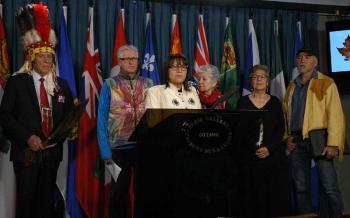Image Caption
By Brett Forester
Windspeaker.com
OTTAWA
Today, April 6, in a press conference on Parliament Hill, the traditional Grandmothers of Pikwakanagan asserted their traditional stewardship and title to Algonquin lands, and restated their disapproval of a proposed industrial development to Chaudière Falls, as well as Albert and Victoria Islands in the Ottawa/Gatineau core.
Renowned architect and Anishinaabe Elder Douglas Cardinal joined the grandmothers in support.
On March 2, the Algonquin Traditional Grandmothers of Pikwakanagan filed a broad statement of claim against Canada’s Attorney General, the chief and council of Pikwakanagan Algonquin First Nation, and the Algonquins of Ontario. The claim extends a similar lawsuit filed in March 2016.
The group’s lawyer is Elders Without Borders’ Michael Swinwood. The present claim has been amended to name the Kokomisag Tiji Pikwakanagan (Traditional Grandmothers of Pikwakanagan) as chief plaintiffs.
“We’re confident,” Swinwood remarked, “that this action will prevail.”
The Kokomisag contend that the Pikwakanagan chief and council do not have traditional authority to represent Algonquin nations at the negotiating table of a land claim with the federal government. On these grounds, the Kokomisag demand that the Pikwakanagan Algonquin First Nation and the Algonquins of Ontario cease negotiating.
A 2015 Agreement-in-Principle signed by the Algonquins of Ontario and the government states that the treaty would include a $300 million payment to the Algonquins of Ontario, a transfer of some 117,500 acres of Crown land to Algonquin fee simple private ownership, as well as several other cultural and economic considerations.
“There are many times, as women,” said Grandmother Jane Chartrand, named as chief plaintiff in the claim, “that women’s counsel has been left unheard, and it was at this time, when we saw what was happening with the Algonquin land claim, that we said, no. We will not allow this.
“It is time for our voice to be heard because we are the women. The women always had a council in traditional government, and we have to exercise our right to the land. Not just for us, but for the next generation of our children, and our children’s children.”
Chartrand suggests the claim is not factionalism, or a coup against the band.
“We must build a bridge with the chief and the council,” she stated. “That’s all we ever wanted to do. All we ever wanted to do was talk with them, to share what we wanted to share for our future generations.”
“The Algonquins of Ontario are a creation of the government of Ontario and the government of Canada,” Cardinal said. “The real representatives are the traditional people and it was the Grandmothers who chose our leaders. It’s the responsibility of us, as Anishinaabeg men, to support the Grandmothers and their guidance.”
Kokomisag spokesperson Greg Sarazin stated that the Pikwakanagan general population expressed concerns over the land claim negotiations. The community voted marginally against the land claim in a formal referendum, while Algonquins of Ontario’s other constituencies voted overwhelmingly in favor.
In a statement to Windspeaker.com, Pikwakanagan Chief Kirby Whiteduck said: “While the action has been filed in court, none of council has been served. It’s not really an action until it happens.”
The chief and council refused other comment. The Algonquins of Ontario did not return inquiries for a statement.
An Ottawa-based company called Windmill Developers proposes to build a commercial, retail, and residential complex across Chaudière Falls and Albert Island, with tangential plans for Victoria Island.
The Kokomisag resist these proposed developments, citing the historical, cultural and spiritual importance of the sites for Anishinaabeg and others.
“Our sacred site, Chaudière, where we always did ceremony, is under attack by what is called progress,” said Chartrand. “We don’t see this as progress. We see this as a taking away once again of something that we hold sacred. It is where we go to do ceremony, where our men had a vision to make this into a place for all of us to go and be in peace; not just Indigenous, but all people.”
Cardinal echoed the sentiment: “They are our sacred islands. This is our sacred circle. For thousands of years Ottawa was always the centre of our Anishinaabeg people. That’s why the immigrants chose this as their capital. It was always the capital. It is a spiritual place of the joining of the four rivers. It is a sacred place where the islands are shaped like a sacred pipe.”
Windmill says it does not “have a legal obligation to consult with First Nations when it comes to privately-held lands,” but has done so in this case, in recognition of the site’s special significance for First Nations.
Swinwood contests the fairness of Windmill’s negotiations with the Algonquins.
His argument rests on legal precedent, set in Canada’s Supreme Court decision in 2014 Tsilhqot’in Nation v. British Columbia for determining Indigenous title to lands. His case contends further that Indigenous law must be considered along with Canadian common law.
The issue boils down to whether the Kokomisag can be considered traditional stewards under customary Anishinaabeg law. Further, they will soon find out whether the courts recognize this title against the authority of elected chief and council.

